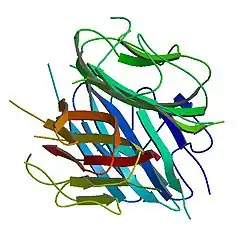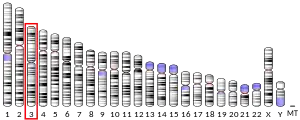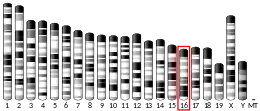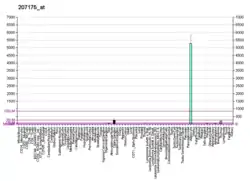脂联素
脂连蛋白(英語:,亦称为脂联素)是一种主要由脂肪细胞分泌的蛋白质激素,由ADIPOQ基因所编码[5],含244个氨基酸。成人体内的脂联素水平与脂肪储量负相关。
结构
脂联素包含244个氨基酸,可分为4个结构域。从其N端起算,第一个是使其定位于细胞外的信号序列,第二个区域较短且在物种间高度变异,第三个65个氨基酸的区域与膠原蛋白相似,最后一个是脂联素的球状结构域。总的上看,这一蛋白与补体片段C1q相似。其中球状结构域的三维结构已经测定,结构上与TNFα非常相似,但在氨基酸序列上却差异巨大[6]。
受体
脂联素可与几种受体结合,两种受体与G蛋白偶联受体有同源性,一种属于钙粘蛋白家族[7][8]:
These have distinct tissue specificities within the body and have different affinities to the various forms of adiponectin. The receptors affect the downstream target AMP kinase, an important cellular metabolic rate control point. Expression of the receptors is correlated with insulin levels, as well as reduced in mouse models of diabetes, particularly in 骨骼肌 and adipose tissue.[9][10]
参考文献
- GRCh38: Ensembl release 89: ENSG00000181092 - Ensembl, May 2017
- GRCm38: Ensembl release 89: ENSMUSG00000022878 - Ensembl, May 2017
- . National Center for Biotechnology Information, U.S. National Library of Medicine.
- . National Center for Biotechnology Information, U.S. National Library of Medicine.
- Maeda K, Okubo K, Shimomura I, Funahashi T, Matsuzawa Y, Matsubara K. . Biochem. Biophys. Res. Commun. April 1996, 221 (2): 286–9. PMID 8619847. doi:10.1006/bbrc.1996.0587.
- Shapiro L, Scherer PE. . Curr. Biol. March 1998, 8 (6): 335–8. PMID 9512423. doi:10.1016/S0960-9822(98)70133-2.
- Yamauchi, T; Kamon, J; Ito, Y; Tsuchida, A; Yokomizo, T; Kita, S; et al. . Nature. 2003, 423 (6941): 762–9. PMID 12802337. doi:10.1038/nature01705. 已忽略未知参数
|author-name-separator=(帮助); 已忽略未知参数|author-separator=(帮助) - Hug, C; Wang, J; Ahmad, NS; Bogan, JS; Tsao, TS; Lodish, HF. . Proc. Natl. Acad. Sci. U.S.A. 2004, 101 (28): 10308–13. PMC 478568
 . PMID 15210937. doi:10.1073/pnas.0403382101. 已忽略未知参数
. PMID 15210937. doi:10.1073/pnas.0403382101. 已忽略未知参数|author-name-separator=(帮助); 已忽略未知参数|author-separator=(帮助) - Fang, X; Sweeney, G. . Biochem. Soc. Trans. 2006, 34 (Pt 5): 798–801. PMID 17052201. doi:10.1042/BST0340798. 已忽略未知参数
|author-separator=(帮助); 已忽略未知参数|author-name-separator=(帮助) - Bonnard, C; Durand, A; Vidal, H; Rieusset, J. . Diabetes Metab. 2008, 34 (1): 52–61. PMID 18222103. doi:10.1016/j.diabet.2007.09.006. 已忽略未知参数
|author-name-separator=(帮助); 已忽略未知参数|author-separator=(帮助)
This article is issued from Wikipedia. The text is licensed under Creative Commons - Attribution - Sharealike. Additional terms may apply for the media files.





